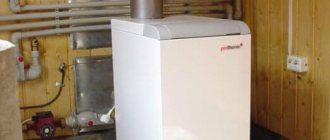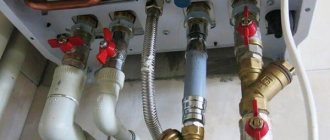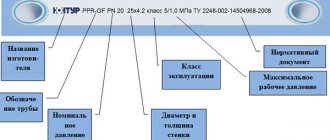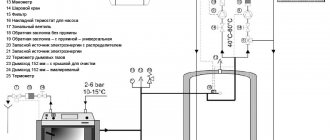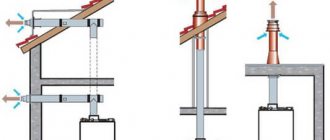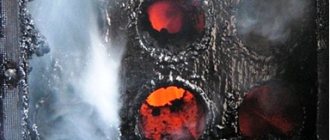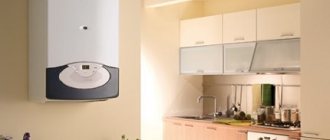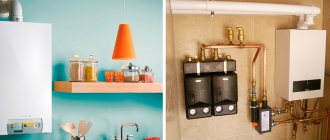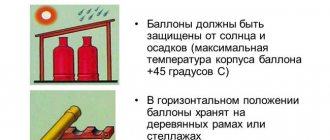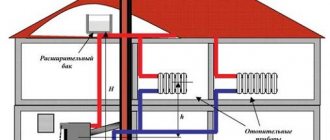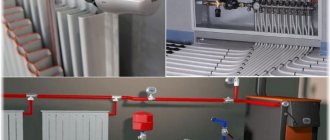Home / Solid fuel boilers
Back
Published: June 26, 2019
Reading time: 5 min
0
1751
Pellet boiler (PC) is a heat generator that is used to generate hot water for heating and hot water needs and uses solid fuel - pellets in granules.
They are made by pressing wood waste: shavings, sawdust, straw, sunflower and buckwheat husks with dimensions of 5-10 mm in diameter and up to 7 cm in length . The calorific value of pellets is 4500 Kcal/kg , which is almost equal to that of low-calorie coal and some wood output.
Modern PCs differ from conventional coal or gas boilers and consist of four main components: a boiler with a pellet burner for combustion, a pellet storage hopper, a fuel supply mechanism to the furnace and an accumulator tank.
The installation of a pellet boiler is carried out by a specialized installation organization. It is equipped with an automatic fuel loading system, which allows it to operate autonomously for several weeks.
- 1 Technical conditions for installing a pellet boiler
- 2 Requirements for the premises under the boiler
- 3 Installation location
- 4 Necessary tools and materials
- 5 Installation of a pellet boiler
- 6 First start of the boiler
Boiler installation
At this stage, you will have to take care of arranging the boiler room and smoke exhaust system.
Boiler room arrangement
The floor and walls of the boiler room must be made of material that does not support combustion. The floor can be made of concrete. If desired, pave it with ceramic tiles.
Place the boiler on a strictly flat surface. Choose a place so that the distance from the front side of the unit to the nearest wall is at least 100 cm. Select the distance from the remaining walls so that in the future it will be convenient for you to carry out preventive maintenance, maintenance and repair of equipment.
Chimney device
Pay special attention to the arrangement of the smoke exhaust system. Not only the efficiency of a homemade pellet boiler, but also the safety of the residents of the house directly depends on the correctness and quality of the chimney.
Select the length of the chimney so that it rises above the roof of the building by at least 50 cm, preferably more.
To make a chimney, use a sealed pipe
It is important that the pipe material does not support combustion and withstands high temperatures.
The chimney must be insulated. To protect the pipe from precipitation, install a protective cone on it.
Make a hole at the bottom of the chimney to remove condensate. For greater convenience, you can connect a tap to the hole. Also prepare a hole for cleaning the pipe from soot.
Choosing a location for installation
After the room for the heating system has been prepared, you need to decide on the place where to install the boiler. Here are a few requirements:
- The floor where the boiler is placed must be level. Only a strictly vertical position of the device is allowed without any tilting.
- The platform under the boiler must be strong to support the weight of a fairly heavy device (some models weigh over 200 kg).
- The boiler can only be placed on a fireproof surface. Tile or concrete are best. Installation on a raised heat-insulating base is allowed.
- There must be at least 1.5 meters from the front wall of the pellet generator to the wall of the room.
- The floor under the boiler should not cool down very quickly when the device is turned off, so that condensation or ice does not form.
In order to subsequently use the system as convenient as possible, the installation of a pellet boiler must be carried out with the expectation that it will need to be constantly approached. At least 1.5 m of free space is required in front of the front wall of the boiler (to add fuel, monitor the flame and draft, and carry out cleaning). If this is not taken into account, then sooner or later the device will need to be dismantled.
Device
Any burner has one goal - creating a powerful flame to heat the air or water jacket of the boiler. At the same time, the combustion power itself can be adjusted independently.
A pellet burner has similar goals. The device is a wind tunnel into which solid fuel is supplied and air is pumped for combustion. Fuel is supplied to the pipe using a special screw-type conveyor. The fuel itself is located in the loading hopper before combustion. The bunker can have a different volume, and it depends on the volume how long the burner can burn on its own without human intervention (adding fuel).
Pellet burner structure: 1 - The pellet enters the burner under the influence of gravity; 2 - Air enters the burner due to the vacuum created by the draft of the chimney; 3 - Pellet combustion occurs in the combustion chamber, which is called the “basket”; 4 - Due to the high temperature, thermal decomposition of wood occurs in the basket, which forms a flow of flammable gases; 5 - A secondary air flow passes under the basket; 6 - In the burner nozzle, the flow of combustible gases and secondary air mixes, forming a torch; 7 - Solid combustion products are ejected from the burner into the ash pan of the boiler or furnace by a stream of secondary air; 8 - Ventilation of the supply channel does not allow hot gases to diffuse up the channel and destroy the pellets, ensuring a stable supply of pellets.
Air is forced into the combustion zone by means of a fan.
The combustion chamber in the burner can be round or rectangular. Round burners are the most common due to their ease of manufacture. A pipe connection is attached to the outside of the combustion chamber, through which fuel is supplied from the conveyor.
The design also includes an ash pit in which combustion waste accumulates. During the combustion of pellets, a little ash is formed, so you need to clean the ash pan no more than once a week when the burner is actively used.
There are several types of pellet burners, each of which has its own advantages and disadvantages.
Flare type
Initially, the device was used to generate heat by burning grain, but later it was converted to burn solid compressed fuel.
Side view of a flare type burner
- Small overall dimensions;
- Can be used in conjunction with boilers with a small combustion chamber;
- Simplified operation;
- Increased reliability;
- You can burn low quality pellets.
- Low power compared to other burners;
- The flame is directed horizontally, which is why it heats the boiler locally.
Volumetric type
Unlike the previous model, they have increased power and high efficiency. The disadvantages of the device include a complicated design, large overall dimensions, and dependence on the quality of the pellets used.
General view of a volumetric combustion burner. Combustion of pellets in a fireplace burner.
Such designs are mainly used in domestic conditions, installed in fireplaces and boilers. The operating principle of the device is as follows: pellets fall into a special bowl, where they are burned under the influence of air supplied from below.
The disadvantages of the model include the size of the device and the need for precise adjustments for proper combustion.
Advantages of using pellet boilers
- Saving effort and time. Automation of the fuel supply process and the ability to set the desired temperature or even program the inclusion of different modes at certain times of the day ensures ease of use.
- Fast heating and maintaining the desired temperature. Thanks to the high efficiency of pellets and the significant power of heating devices, it is possible to quickly achieve and maintain the desired temperature regime for a long time, including in large rooms.
- Convenient storage. The main requirement for storing pellets is low humidity. Otherwise, this type of fuel is much more convenient: it does not leave a lot of dirt and dust, like coal, and is not explosive, like
- Low level of electricity consumption, which is required only for the operation of automation and the fan.
- Environmental friendliness of pellets. This type of fuel does not emit toxic substances when burned.
Boilers "Teplodar" on pellets
Teplodar pellet boilers have a well-thought-out design, small size and high power. Universal devices can be easily converted to wood or gas if necessary. The boiler body is lined with basalt cardboard, which ensures more efficient heating of the coolant and safety during operation.
Our company’s engineers have developed effective models of pellet boilers “Kupper OK” and “Kupper OVK”. The Kupper OVK model is additionally equipped with a hob, which is convenient for boiling water or heating food.
Depending on the size of the heated room, you can choose the modification you need in terms of power: boilers are designed to heat a room from 100 to 300 m². The efficiency level reaches 83-89%, which ensures economical fuel consumption.
Principle of operation
Operating principle of a pellet boiler (click to enlarge)
However, serious competition comes from alternative heat sources, among which a pellet boiler for heating a home is the most profitable solution. At first glance, there are no fundamental differences. In the heat exchanger, which is built into the combustion chamber, water is heated, which heats the house.
Why are the most productive gas boilers made using innovative technologies economically inferior to their self-made analogues that run on pellets? The answer is simple, the cost of 1 kW of energy when burning gas will be higher than the same amount of heat using alternative fuel.
The raw material for pellets is wood processing waste, the cost of which is minimal, since the issue of their disposal is very acute and the production of fuel pellets is one of the ways to get rid of unwanted products of the main activity. You can make pellets with your own hands, but this will require special equipment.
Installation Features
pellet boiler
If you decide to use pellet boilers to heat your home, you should pay special attention to their installation.
When installing the boiler, it is necessary to take into account the material of its manufacture. If the product is made of boiler steel, you can do without a separate foundation.
The average weight of the boiler is 300 kg. This allows it to be installed on a concrete ceiling without the use of reinforcement structures. Cast iron models require a monolithic foundation.
It is important to know that strengthening of the base also occurs under bunkers with a carrying capacity of more than one and a half tons.
When burning pellets, a small amount of ash is produced. This eliminates the need for frequent boiler cleaning. To achieve maximum results, it is necessary to consider the possibility of installing a large ash pan. This allows cleaning to be done once a week. Do not neglect cleaning the boiler, as this will reduce the efficiency of the boiler.
Review of Russian-made pellet boilers: //6.com///-pelletnye-kotly.html.
Pellet boiler connection diagram (click to enlarge)
Installation of a heat generator consists of the following steps:
- Installation of the distribution ridge;
- Installation of a pump circuit for consumers;
- Installation of protective devices;
- Installation of expansion tank and shut-off valves;
- Connecting the device to the supply and return circuits;
- to start the coolant in the circuit;
- Test run of the boiler and quality control of its operation.
The installation of a heat generator has its own characteristics. It all depends on the type of boiler, its power, characteristics of the heating system and hot water supply. It is important to remember that the harness must meet high requirements. There are reasons for this.
First of all, it should be noted that for the operation of the device it is necessary to use fuel with low humidity. It is also important to heat the boiler components to a high temperature. Poorly executed piping can lead to interruption of the heat generator and rapid wear of individual parts and assemblies.
In accordance with fire regulations, pellet boiler pipes must be made of non-combustible materials. The ideal solution today is polypropylene pipes. However, in practice this is not the case. At the outlet, the coolant has a high temperature, which significantly exceeds the temperature limits of polypropylene heating pipes. This leads to rapid wear of the system.
A pellet boiler is a rather complex device that must be installed and secured very carefully. Therefore, it is not recommended to do it yourself. Of course, if you have certain skills and knowledge, then anyone can do this job. But still, if possible, it is better to resort to the services of specialists.
The heat generator is connected as follows
- to put the kettle on;
- Connect the appropriate burner;
- Set up a funnel to hold the specified amount of granules;
- Install the screw that is used to supply fuel to the combustion chamber;
- Installing a control panel to manage the system.
After completing all these steps, you can move on to the next steps:
- Install the pressure gauge, bleed valve and air bleeder valve;
- If necessary, install a thermal valve sensor;
- install a chimney that meets all requirements;
- Installation and connection of all devices that support reverse flow of coolant;
- Installing an uninterruptible power supply to avoid malfunctions of the boiler.
Features and advantages of pellet boilers Reconstruction: http://6.com//otoplenie/-Peresvet.html
About the pellet burner
A pellet burner is a special heating device that produces heat by burning pellets or fuel granules in a boiler. In some cases, these burners use unnecessary dry grain.
There are manual and automatic burners; in automatic burners, fuel is supplied to the combustion hopper using a special auger, and the entire process is controlled by sensors, due to which the device requires minimal control from the user. Pellet burners have found their use not only in everyday life, but also in industry. They are used for space heating, water heating and to meet a number of other needs.
Pellets, or fuel granules, are a special solid fuel that is obtained from wood or agricultural waste by pressing and granulating under high temperatures.
Pellets are an environmentally friendly type of fuel, since when they are burned, the same amount of carbon dioxide is released into the atmosphere as is formed during the natural decomposition of wood
In countries where agriculture and the woodworking industry occupy leading positions, the cost of pellet fuel is much lower than that of coal. The only exceptions are those regions in close proximity to which coal mining enterprises are located.
When burning pellets, hazardous fumes are not released, as happens when burning liquid fuel.
Making a pellet burner
Pellet installations are often ignored by buyers because of their high cost compared to gas and electric equipment, and the problem is solved by making the device at home.
General diagram for making a pellet burner yourself
The combustion chamber can be constructed from a square or round pipe. It is better to give preference to heat-resistant steel that can withstand elevated temperatures; the wall thickness should be at least 4 mm.
The home-made installation is fastened to the boiler using a flange plate made of heat-resistant steel with a thickness of 3 mm.
A container for supplying fuel to the combustion chamber can be purchased or made by yourself. The best option is to immediately make an installation in which fuel will be supplied automatically. To do this, place an auger in the purchased pipe of the required diameter. The rotation of the device will be carried out by a bearing, gearbox and motor operating at low speeds.
Additionally, the store can purchase a fan that will pump air. The fan is mounted on a plate, which is made depending on the size and door design of the boiler used in your home.
It is also important to take care of adjusting the amount of incoming fuel and the volume of air pumped by the fan, otherwise the homemade device will work unstably. In home devices, the air supply force and the number of pellets are adjusted manually
This method is inconvenient because it requires constant supervision of the burner.
For automation, an electrical incandescent element and a photosensor are purchased. The first device ignites the flame if the pellets go out and also regulates the switching on of the device. The photo sensor monitors the appearance of the flame: if the flame is stable, the sensor transmits a signal to the glow element to stop ignition.
To automate the system, a filling sensor is also purchased. It will notify the electronics of the device about the degree of filling of the combustion chamber with pellets.
Pellet burners are modern equipment for boilers, which can improve the environmental friendliness of the process and reduce fuel costs. At the same time, the equipment in the store itself is expensive. For basic household needs, it is better to give preference to homemade devices, the operation of which can be automated if necessary.
Minimizing housing maintenance costs is one of the most important tasks today. The search for cost optimization means is ongoing. Heating a home, with regularly increasing tariffs, is a significant item in the family budget.
You can reduce it in several ways. Using energy-saving technologies in building a house and using efficient heating systems. A pellet boiler is economically more profitable than its gas-fired counterparts, not to mention electricity and other energy sources. The reason lies in the low cost of consumable raw materials and the high energy efficiency of the device.
Correct boiler settings
When buying a pellet boiler, first of all you need to pay attention to the availability of service centers and official representative offices in the region where the boiler is installed. The pellet boiler is fully automated and requires proper configuration and maintenance. Correctly setting up the boiler will increase its service life, reduce fuel consumption and simplify cleaning the boiler. Start-up and commissioning of this kind of automated equipment must be carried out by a specialist authorized by the manufacturer. In fact, there are no restrictions on starting the boiler and putting it into operation; this procedure can be performed by the installer who installed the heating system, and of course by the user himself. But in this case, all responsibility and further maintenance falls on the person who carried out the launch.
What is important to know to set up a pellet boiler yourself? First of all, you need to understand that an automatic pellet boiler has several operating modes. The most basic and those that require more attention are three: Ignition, Work, Pause. Boiler manufacturers use different types of automation in which all kinds of additional modes can be used, such as: Combustion Stabilization Mode, Modulation Mode, Supervision Mode, etc. When we already have an idea of the modes, it is important to understand how the boiler should behave in each mode.
Ignition mode - when a certain portion of pellets is supplied to the burner using an igniter, or in manual mode it is ignited and complete combustion is stabilized. The boiler usually spends about fifteen minutes in this mode, during which time it also supplies pellets in certain portions, while the boiler automation monitors the temperature of the flue gases. In this mode, it is very important to set up a sufficient amount of pellet supply and air injection so that the temperature of the flue gases rises rapidly. After the flue gases reach 60 degrees, the chimney is considered warmed up, and the automation switches the boiler to Operating mode.
We recommend: Specific heat of combustion of kerosene: the physical meaning of the value, the meaning of the indicator and its comparison with oil
The operating mode is very similar to the ignition mode. The boiler spends most of its time in this mode. It is at this time that it heats the boiler heat exchanger and brings the temperature in the heating system to the set temperature. During our work, we no longer need to quickly warm up the chimney. Our task is to achieve correct and complete combustion of pellets, a stable and clean flame. Two parameters are subject to adjustment: air blowing power and the number of supplied pellets. The air power is usually regulated in a ratio from 30 to 100 percent, the number of pellets supplied to the burner is regulated in a cyclic ratio, and after a certain period of time a certain portion of pellets is supplied. It is important to understand that the portion of burned pellets corresponds to the declared power. For example, a fifty kilowatt boiler will not be able to provide heat to the room if the supplied pellets are too small, even if the flame is stable. The average heat transfer of pellets from one kilogram when burned can produce up to five kilowatts of thermal energy per hour. The quality of the fuel can greatly affect the consumption of pellets, and in some boilers, the operation of the burner.
Manufacturers of pellet boilers provide standard operating settings. Each power has its own number of pellets per hour and its own air blowing power. Our task as a user or boiler setup specialist is to adjust these parameters so that pellet combustion is complete and consumption is minimal without loss of boiler performance.
This begs the question, where to start setting up a pellet boiler?
We recommend that you first start by adjusting the air and blowing power of the fan. The blowing power may vary for each boiler; it is usually influenced by a number of factors, such as chimney draft, pellet quality and even burner type. The amount of air pumped into the burner should be the minimum necessary for complete combustion of the fuel. This can be determined by the color of the flame.
The correct flame has a yellowish tint, the flames rise upward, the combustion is even, high and stably kept at the same height. It is in such a flame that maximum efficiency is achieved.
Is the flame reddish with noticeable smoke? There is not enough oxygen for combustion; this can be affected by both an incorrectly installed chimney and too little air blowing power. Try adding blowing power and observe the result.
If we observe an aggressive flame, and pellet coals jump up and fall into the ash pan as unburnt pellets, there is too much air blowing, we recommend reducing the air to the minimum required for combustion.
After the flame has been normalized and it meets all the parameters of proper combustion, it has a yellowish tint. Let's move on to adjusting the auger feed. As mentioned above, the auger operates cyclically, feeding certain portions into the burner. Before setting up the auger feed, you need to understand what type of burner your boiler has. A torch burner requires the minimum required number of pellets when burning, so that the pellets do not clog the air supply holes. In such burners, pellets are usually fed in small portions. If we are dealing with a retort burner in the form of a bowl with bottom fuel supply. Here the fuel supply occurs somewhat differently; the pellets supplied from below constantly raise the combustion. Our main task is to adjust the optimal supply of pellets to the burner so that the fuel during combustion is always at the same level. Combustion should occur in the upper part of the burner, and the pellets should not spill over the edge of the burner or sink below the level.
After we managed to select the ratio of pellet supply and air inflation, we should observe the temperature of the water in the system, whether it tends to the set one, and at what speed. Is the boiler gaining temperature very slowly or is the temperature stuck in one place? This means that the boiler is not operating at rated power; it is necessary to add fuel supply and adjust combustion.
We recommend: We understand what pressure testing of a heating system is and how to test it yourself
The final mode is Pause or Stop mode. The pellet boiler goes into this mode when the set task, namely the set temperature, has been achieved. In this mode, the boiler completely turns off the operation of the auger and fan, and waits for the water temperature in the system to drop by several degrees, after which it starts working again, before checking the combustion.
The question is very often asked: Is it necessary to reconfigure the boiler when changing fuel? If these are fundamentally different fuels then - Yes.
For example: We made a tincture using wood pellets, and a little later we decided to switch to husk pellets. Husk pellets burn a little faster than wood pellets and the feed ratio of the auger to the fan needs to be changed.
If the fuel is simply from different batches or from a different manufacturer, then only a slight adjustment of one of the parameters will be necessary. Pellets may differ in density, humidity, calorie content, as well as ash content and the likelihood of caking and cake formation.
Pellet boilers have gained popularity in the line of solid fuel boilers due to their autonomous operation and convenient operation. Such boilers can work from 2 to 10 days on one loading of the bunker and with cleaning the boiler every 4-5 days, while a long-burning boiler with automation will not last even 24 hours and needs regular cleaning before each loading of firewood. However, pellet boilers require proper tuning and it is better to entrust commissioning work to a specialized organization. A properly configured boiler will easily develop the specified power, and the savings on pellets will pleasantly surprise you.
We make it ourselves
Having decided to do everything yourself, you should first develop a project. Guided by the drawings, you should purchase everything you need, as well as prepare the tools.
What will you need?
It is better to purchase the most complex elements already assembled. Thus, a factory-assembled pellet burner is always preferable to one assembled by yourself. The same applies to sensors and programmers, a fan, an electric motor for the auger, a grate, two oven doors, if you do not plan to manufacture them yourself. You will also need:
- steel sheet 3mm and 6mm thick;
- steel square and round pipes (wall thickness 4 mm);
- asbestos sheet and in the form of a sealing cord;
- fireclay brick for the combustion chamber;
- round bar (20 mm);
- electrodes.
To carry out the work, you need to prepare a grinder, a welding machine, a ruler, and a drill.
Pellet supply unit
We are preparing a bunker for pellets. We connect it to the auger shaft. The latter can be in the form of a pipe. If a fuel dispenser is provided, install it at the entrance to the auger shaft and connect it to the electric motor.
Heat exchanger
Square pipes are used as front pipes, round pipes are used as connecting pipes. In the front ones, round holes are cut for supply and removal of coolant.
The spatial arrangement of the connecting pipes at the time of welding is carefully controlled. After completing the welding work, check the tightness of the seams by filling the heat exchanger with water.
Case manufacturing and assembly
The body is made from sheet steel 6 mm thick. We provide two doors for subsequent maintenance of the equipment, located in the front and rear parts. We lay fireclay bricks inside the chamber.
We place the heat exchanger inside the housing, providing a small gap between the outer surface of the first and the inner surface of the second. Install the fan at the top of the case.
In many regions, the problem of heating private houses still remains relevant. Of course, the modern market offers a huge range of equipment that uses a wide variety of materials as fuel, be it gas, firewood, electricity or oil, etc. However, access to gas mains and stable power grids is not available everywhere, so solid fuel heating remains the most preferable in many regions.
One of the best options for a solid fuel heating unit is a pellet boiler, which you can assemble with your own hands.
Contents of step-by-step instructions:
Common Mistakes
During the installation of a heating system, mistakes are often made, including:
- Lack of control of the return water temperature (this error leads to condensation, soot and tar appearing in the boiler). There are several options to solve the problem; installation is required: - return water recirculation; — three-way valve; - hydraulic guns.
- Damage to the tightness of the chimney, bunker and boiler, reducing the efficiency of the device.
- Lack of thermal insulation of the base (condensation may form due to temperature differences).
- The first start-up is very important and must be carried out by a specialist (the controllers are not configured, this must be done on site, taking into account the burner power and operating mode, chimney draft). Therefore, commissioning work must be taken seriously.
- The size of the boiler room does not comply with the manufacturer’s recommendations. There is often a situation when a pellet boiler installed in a small room suddenly needs cleaning at a certain stage of operation. And this process involves removing the auger, which, due to its length, rests against the wall of the room.
- Lack of supply ventilation
Some technical features of installing a pellet boiler:
— A return temperature controller must be installed. You will get rid of condensation, reduce the formation of soot, and increase efficiency. — The chimney, boiler, bunker and combustion chamber container must be sealed.
In case of power outages, it is worthwhile to provide a source of uninterrupted supply.
Please note that installing boilers of this type is a complex and responsible job. The installation of boiler houses using pellet equipment should be trusted to specialists and companies that have the appropriate licenses. The quality of heating of the room and the amount of savings that will be spent on the subsequent operation of the system depend on the correctness of the work performed.
>Gas or pellets?
Advantages and disadvantages
The equipment has a number of advantages:
- Pellets are a safe fuel compared to gas and electricity;
- Allows you to significantly reduce space heating costs compared to using electric boilers. At the same time, pellet installations are more expensive than gas equipment, but do not forget that it is not always possible to supply gas and purchase gas cylinders;
- Homemade installations guarantee high efficiency - 95%. Some store installations are over 97%;
- They are used not only for heating the room, but also for producing hot water;
- There are no rules for transporting and storing fuel. When near a person, pellets do not cause allergic reactions, and there are no toxic fumes when burning;
- Fuel is available for purchase. Equipment owners complained about the lack of fuel and the need to prepare a supply of pellets from the winter when the devices appeared; now there is no need to store a large volume of pellets at home; if necessary, they can be bought everywhere;
- The price of pellets is on average at the same level, unlike gas and electricity, the tariffs for which periodically experience seasonal fluctuations;
- Installation of the device does not require special skills, and there is no need to coordinate the installation with authorized bodies;
- After combustion of pellets, natural mineral ash is formed, which does not require special rules for disposal.
Along with the advantages of such equipment, there are also a number of disadvantages:
- High cost of ready-made store equipment. Despite the popularization of devices in recent years and some reduction in prices, pellet boilers are still more expensive than gas or electric equipment of similar power;
- The equipment requires constant maintenance (especially outdated models). The user will have to clean the ash pan and heat exchanger from accumulated ash once a week. In modern models, cleaning is provided at an automatic level;
- In the absence of automatic fuel supply, the user has to load pellets into the bunker manually;
- It is necessary to ensure minimum humidity conditions in the rooms in which pellets will be stored awaiting use;
- Imported equipment is practically not designed for the conditions of the harsh domestic winter, as a result of which breakdowns and malfunctions often occur;
- In remote areas, fuel for the winter still has to be stored due to the instability of supplies.
Advantages and disadvantages of pellet boilers
Pellet boilers have a number of advantages:
- Automaticity. If necessary, the boiler is equipped with a pellet storage bin. This allows you to avoid wasting time on daily fuel loading. Automatic pellet feeding does this itself in accordance with the specified settings. The electrical control panel allows you to set the required operating mode.
- High efficiency. Pellets of the same volume as wood produce twice as much heat. This happens only if the granules are of high quality and are properly stored and transported.
- Environmentally friendly. These devices are equipped with a closed combustion chamber, into which air enters from the atmosphere, so oxygen from the room is not burned. Pellet granules are produced without chemical additives and, when burned, minimally pollute the environment.
Pellets are an environmentally friendly product - A small amount of ash. The pellets burn almost completely and leave much less ash than similar solid fuel boilers.
- Low noise and low power consumption. Only 60 watts are enough to operate the electronic part.
Disadvantages of pellet equipment:
- Pellet granules absorb moisture very well, while greatly reducing the amount of heat generated. Therefore, they are demanding in terms of storage space. Also, when purchasing fuel for the whole season, you may need a separate room, as it takes up a lot of space.
- Although the efficiency of such boilers is higher, the cost of fuel is higher. Therefore, on average, a unit of heat is still more expensive than other solid fuel devices. You should also take into account the initially high price of such equipment.
- Pellet boilers use a specific burner; you cannot load anything into them except special pellets.
Pellet boiler burner - Dependence on electricity. Even if you install a hopper and automatic feed, it will not work during power outages. To protect yourself from heating interruptions, you should additionally buy a generator.
Wood or pellet heating – which is more profitable?
Let's calculate whether a pellet boiler is profitable compared to solid fuel devices that burn wood. For the initial data, let's take the characteristics of the Zota Pellet 15a boiler. The operating instructions indicate that under the same conditions, 36 kg of pellets and 64 kg of firewood will be consumed per day. As we can see, the gearbox of pellet granules is almost twice as high.
But when calculating profitability, it is necessary to take into account the cost of raw materials. So, a kilogram of good pellets costs on average 15 rubles per kilogram, firewood 5 rubles. Per day it will be 36 kg * 15 rubles. = 540 rubles for pellet heating and 64 kg * 5 rubles. = 320 rubles. It turns out that on average it is more economical to use wood heating.
Starting and maintaining the boiler
Comparison of heating costs
The equipment can be started only after installing the pellet boiler and connecting the corresponding heating system pipes to it. Once the mentioned tasks are completed, turn on the cold water supply to the heating system.
Observe the operation of the boiler. If any unusual symptoms occur, turn off the equipment and do not use it until the problem is resolved.
Observe the boiler operation
Homemade pellet boilers, like any other heating units, require appropriate care.
Every 2-3 weeks, empty the ash pan of waste. Clean the smoke exhaust duct every 2-4 weeks. This will not take you much time, but ignoring such simple maintenance will lead to a significant decrease in the efficiency of the boiler and make the equipment potentially unsafe.
If desired, additional automation equipment can be connected to the pellet boiler. This will make the operation of the equipment more convenient - you can simply forget about the need to reload fuel and other related activities for some time.
Modern automation tools even allow you to set up remote control of the heating unit, which is also very convenient.
And these are not the only possible additions. How do you like, for example, self-cleaning systems for boilers? Be sure to study the available modifications and, if desired, purchase such additions for your boiler.
Boiler with pellet hopper
You can assemble a simple pellet boiler with your own hands, following the instructions you received earlier.
Video - Operating principle of a pellet boiler
The unique smell of natural wood, a clean and decorated room in a modern style - this is exactly what a boiler room in a house can look like if you choose the right equipment. Innovative heat-generating equipment that will create the described conditions indoors is a pellet boiler or an automatic pellet burner, running on special fuel pellets, which are created from waste from agro-industrial or woodworking production.
If just a few years ago pellet installations were used in only 20% of homes in Europe, now the figure has increased to 70%. The use of pellet boilers and burners is the most beneficial option for heating a living space from an environmental and economic point of view. Today we will talk about the operating principles of the equipment, its advantages and disadvantages, and also consider a diagram for making a pellet burner with your own hands.
Installation instructions for a pellet boiler
Of course, you can install the unit yourself if you have special knowledge, but it is better to seek qualified help from a specialized organization that has a construction license.
The main and important stage during installation is professionally executed design. This is followed by the following steps for installing heating equipment:
- Preparatory stage. Includes preparation of the boiler room, construction of a platform for the boiler, installation of a chimney, ventilation;
- Installation of the heating unit on a hill;
- Connecting the heating system pipes and hot water supply to the boiler;
- Connecting the smoke exhaust duct;
- Setting up and starting up the heating device.
Preparatory work
The boiler room should be prepared - the base should be leveled and strengthened, which should support a weight of up to 200 kilograms. According to the requirements, the boiler is installed vertically, so there should be no slope. The base must have a fireproof surface.
Electrical wiring is needed to automate the heating device and to illuminate the boiler room, which will provide convenience during operation. Construction of a sandwich type chimney with a height of at least 5 meters. A chimney and ventilation are also installed.
Boiler installation and piping
Installation and strapping occurs in the following sequence:
- The delivered boiler is mounted on the podium;
- The fuel compartment and the auger feeding pellets are mounted;
- The distribution comb is connected;
- The expansion tank and shut-off valves are being installed;
- The boiler is connected to a circuit supplying coolant and a return circuit.
Chimney connection, start-up and commissioning
After the system has been filled with coolant (water, ethylene glycol or propylene glycol), it should be connected to the chimney.
Moreover, the diameter of the chimney must correspond to the diameter of the outlet pipe. And the height of the chimney is in accordance with technical requirements. The appropriate diameter will provide good traction regardless of wind strength and air temperature. Good traction is the key to efficient operation of pellet equipment. But this type of boiler is afraid of strong draft, but too little draft will not work. Therefore, to solve this problem, a traction stabilizer or a slide valve is used.
Most often, the chimney is made of a metal pipe, in which hatches are constructed for further cleaning. The chimney should also be equipped with a device for draining condensate and insulated. An important step is pressure testing; if it is done poorly, pyrolysis gases will leak, which will lead to a decrease in efficiency.
Afterwards, a test start-up and adjustment is carried out. A malfunctioning device will lead to the following problems: the boiler will smoke, smoke, go out and the pellets will not burn completely.
Installation of a pellet boiler
There are high demands on PC installation. This is due to the fact that according to the technology, the moisture content of the fuel must be minimal, then the coolant is heated to high operating temperatures.
Improper installation will lead to violation of the operating conditions of the boiler and its auxiliary elements, which will create an emergency situation and equipment failure.
In accordance with fire safety requirements, heating and power equipment is connected only with metal pipelines. Polypropylene structures cannot be used, since the temperature of the hot water leaving the PC exceeds the working tolerances of the polymers.
To ensure reliable operation of the boiler room, it is recommended to connect two different phases as power supply. One for the functioning of the PC and auxiliary equipment, and the other for lighting needs.
This greatly simplifies the repair work on the main components, so as not to do them in the dark. In addition, independent lighting of the boiler front will help to carry out routine maintenance work efficiently.
After checking the equipment according to design specifications, they proceed to direct installation.
Installation algorithm:
- Installation of the PC, connection of the gas-air path with the chimney.
- Installation of pellet bunker.
- Connecting the fuel auger.
- Assembling and setting up a PC control panel: pressure gauge, safety valve and air vent.
- Connecting pressure gauges and thermometers to the circulation pump.
- Installation of automatic control of heating of the return coolant.
- Placement of backup power supply and voltage stabilizer.
Before launching, commissioning work is carried out:
- checking for compliance of the assembled boiler room diagram with the project;
- checking the tightness of the gas path;
- pressure testing of PC and heating system;
- checking the functionality of security automation;
- control start-up, measurement of operating parameters and performance of a set of adjustment works.
After completion of installation and construction work, adjustments are made, otherwise the equipment will operate with low efficiency, excessive consumption of fuel and electricity.
Boiler Assembly Guide
Pellet boilers have a rather complex design. The instructions for assembling them will also be difficult and multi-step. For greater convenience, the assembly process of each main unit is considered separately. Buy or make the necessary elements, and then simply assemble them into a single system.
It is highly recommended to buy this element of a pellet boiler ready-made. The burner is where you will spend the most money.
Making a burner yourself is almost impossible for the reason that this part of the boiler is not simply a container for igniting loaded granules, but a complex control and regulatory mechanism.
Pellet burners are equipped with special sensors and have several preset programs that allow you to achieve the most efficient fuel consumption and ensure the most efficient heating of your home.
Housing and heat exchanger
You can handle the assembly of the housing and the manufacture of the heat exchanger yourself. It is best to make the boiler body horizontal - with this placement of the unit, maximum heating efficiency is achieved.
It is recommended to use fireclay bricks to make the body. You simply assemble a kind of box without a top cover and place a heat exchanger in it with connected pipes and other elements. Brick is recommended for the reason that it accumulates heat much more efficiently than cast iron, steel sheets and other popular materials.
The heat exchanger of a pellet boiler is a system of pipes interconnected and connected to the heat supply pipes of a private house.
First step. Assemble a rectangular heat exchanger from square pipes. To do this, cut the pipes into pieces of the required length and weld them into a single structure.
Second step. Make holes in the profile that serves as a vertical post for connecting round pipes.
Third step. Prepare holes in the remaining front pipes for drainage and water connection pipes. Hot water will be discharged through the top hole, cold water will be supplied from below.
Use metal pipes with a length of 150 mm. Next, you can use polypropylene pipes. Be sure to install ball valves where the pipes connect to the boiler. Additionally, you can install filters if necessary.
Fourth step. Weld the back of the unit to its front and weld the side pipes.
At the same stage, select a convenient place to connect a chimney pipe with a diameter of 10 cm. At the bottom of the heating unit, provide a small chamber for collecting ash. Also, the design of a pellet boiler necessarily includes a firebox. More about him later.
In the firebox, as already noted, pellets are stored and from here they are supplied to the burner.
First step. Prepare the necessary materials and equipment. You will need an auger with a diameter of 7.5 or 10 cm, an electric motor and a metal casing. You will connect the engine to the pellet burner control unit.
The function of a metal casing can be performed by any container of suitable volume with sufficiently thick walls.
Second step. Install the inlet pipe of your auger into the discharge mouth of the casing. Connect a corrugated plastic pipe to the other part of the auger to supply granular fuel to the burner.
In conclusion, all you have to do is assemble all the listed elements into a single structure. Do this and proceed to installing the boiler.
Principle of operation
All pellet installations that can be purchased in the store are equipped with additional components:
- Auger – supplies fuel from the bunker to the combustion chamber;
- Controllers for automating the work process;
- Bunker – the place where the fuel is located before being supplied to the combustion chamber;
- A lambda probe is a special sensor that monitors the oxygen content in smoke chambers and independently controls the fuel combustion process depending on conditions.
The pellet burner must be protected with a plastic corrugated pipe. It acts as a fuse when reverse draft occurs. If the fire begins to move towards the bunker, the pipe burns out, preventing the flame from spreading.
Additionally, a fan is used, which enhances the combustion of pellets by pumping air, as well as a thermoelectric heater, which allows the fuel to be ignited without human intervention.
In automated devices, pellets are fed into the combustion chamber automatically; a person is only required to monitor the amount of fuel in the bunker. The need to supply fuel to the combustion chamber is determined using temperature sensors (they can monitor the air temperature in the room, the water temperature, or any other environmental indicators depending on the operating mode of the equipment).
The required temperature of the coolant is set by the user, all further increases and decreases are controlled using automated equipment. As soon as the temperature reaches the set level, the burner begins to operate in standby mode (the pellets do not go out, they begin to smolder). If the temperature, on the contrary, drops, the controller activates the built-in fan. Under the influence of air, the pellets flare up and the burner goes into operating mode. If during downtime the pellets go out for any reason, the heating element is activated, which re-ignites.
basic settings
A pellet solid fuel boiler is considered very convenient to use, but unlike other solid fuel models it requires proper configuration. A correctly configured ratio of parameters directly affects indicators such as the power and efficiency of the boiler.
A very common question: is it necessary to reconfigure the boiler when changing a batch of pellets? Yes, your solid fuel boiler using different pellets will work differently. The ratio of components from which pellets are made is different for each manufacturer and therefore the combustion process will also be different.
The principle of a pellet solid fuel boiler is quite simple: a worm mechanism (auger) feeds small granules of compressed wood, coal, biomass, etc. (pellets) into the burner, and air is also forced into it to ensure the required flame power.
Two parameters are subject to adjustment: pellet supply speed and air blowing power. The air supply is adjusted by simply selecting the rotation speed of the blower fan, usually either on a scale from 1 to 10 or in % from 1% to 100% (depending on the model of the solid fuel boiler). The pellet feeding speed is adjusted by increasing or decreasing the period between activations of the worm mechanism. The rotation speed of the screw is always the same.
The amount of air pumped into the burner should be the minimum necessary for complete combustion of the fuel. This can be determined by the color of the flame. A red flame with noticeable smoke is a sign of lack of air. A white flame means the fan is blowing too much air.
The correct flame is yellow. An additional sign of proper air supply is that the flame not only rises upward, but also diverges slightly to the sides.
When adjusting the air supply, do it in the minimum permissible increments. The more accurately you set the minimum required point, the more boiler power and less pellet consumption you will achieve.
First of all, the air supply is adjusted, and then the pellet feeding speed.
The feed rate of pellets into the burner should be optimal. If too few pellets are supplied, then it will be difficult to accelerate the solid fuel boiler to rated power - there will simply be nothing to burn, and if there are too many pellets, then excess fuel will fall out of the burner.
We recommend: Flushing the heating system in a private house with your own hands, how to flush heating radiators
The APG-25 Teplodar pellet burner is started by pressing the button located on the side of the hopper once. The device is put into standby mode. To go to the main equipment settings, you must simultaneously press the “Left” and “Right” arrows. Secondary parameters of APG-25 are set during heating or maintaining temperature.
The user needs to set two main parameters:
- Feeding time in “Heating” mode
. The default is 9 seconds with a cycle time of 20 seconds. This is a system setting for a 20 kW boiler heating a room of 180-200 square meters. m. If such power is not needed, the indicator is reduced to 5-6 seconds. The feeding time in the “Maintenance” mode is determined automatically. - Fan power
. The user manual indicates which blade rotation power is selected depending on the pellet feeding time. The parameter is set manually. If the fuel supply is short, the fan operates in moderate mode.
The fan power also affects the speed at which ash is blown out of the fryer. For poor quality pellets, it is necessary to set the parameter slightly higher than the table value, in particular, when working in the “Maintenance” mode.
